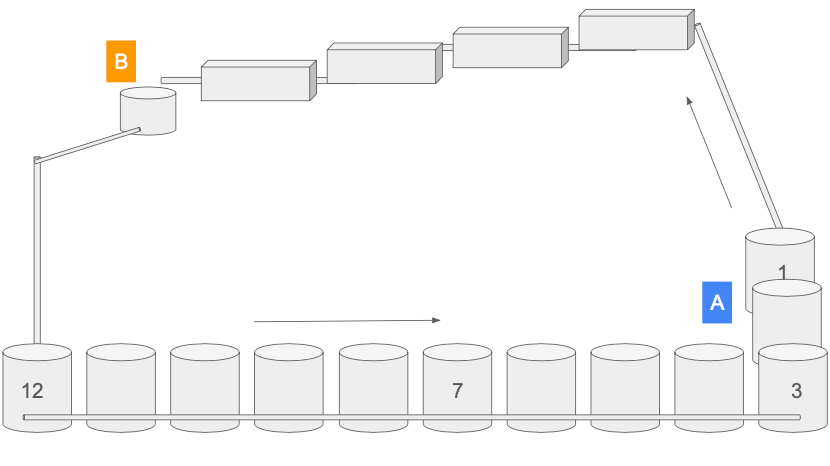Portable Wetland for Southern California
What if Portable Wetland for Southern California could help restore the rich biodiversity of our geological basins by hydrating critical soils that foster life?
As a part of Getty’s PST ART: Art & Science Collide initiative, Lauren Bon and Metabolic Studio are showing Portable Wetland for Southern California, a conceptual artwork and experimental proposal for ecological remediation, at Brackish Water. Located on the California State University, Dominguez Hills campus in South Los Angeles, “where local rivers have been transformed into concrete channels, and where industrial contamination and ecological racism have plagued surrounding communities for generations,”1 the exhibition considers issues of “access, inclusion, ecological racism, and cultural/class system interchanges along Los Angeles’ waterways.”2
Portable Wetland for Southern California was initially developed by Lauren Bon as part of Bending the River, an infrastructural artwork utilizing adaptive reuse and reconnecting the City of Los Angeles with its original source of water, the Los Angeles River. By capturing the recycled water and urban runoff that travels in the river’s low-flow channel and returning it to the watershed by using it to irrigate the adjacent LA State Historic Park, we are rescuing a precious resource that would otherwise flow out to sea. This captured water, however, needs to be treated to meet state and local water quality requirements, and we want to incorporate an organic approach rather than relying solely on conventional treatment methods.
Wetlands are one of the most sophisticated water treatment systems that nature has ever created. They feature some of the highest levels of biodiversity found on earth, and are capable of removing many contaminants of concern, including metals, nutrients, and bacteria. While wetlands are now protected by federal law, they have historically been undervalued and many natural wetlands were overtaken and destroyed by urban development — Bending the River is an opportunity to bring them back.
While we will still utilize traditional water treatments, this project presents a rare opportunity. Integrating a wetland component to the process mimics the wetlands that flourished on the historical floodplain of the LA Basin, while also taking advantage of native plants that have bio-adapted to thrive in oxygen-poor wetland soil. As the holder of the LA River’s first private water right, Bon has a responsibility for the stewardship of that water. When the river water passes through water treatment at Metabolic Studio, we can conduct real-world experiments, and demonstrate new ways to look at water conservation.
The wetland design team created a modular horizontal-subsurface flow wetland system, built from off-the-shelf components so it is easily replicable and deployable, with a modular design with the flexibility to accommodate sites with varying conditions. We performed tests using three different media and determined scoria, crushed volcanic rock provided superior filtration. The scoria we used is also symbolic. It was gathered from the Owens Valley, called Payahuunadu by the indigenous Paiute people of the area. Owens Lake is the original water source of Los Angeles’ famed aqueduct system and the lake’s water was stolen to serve Los Angeles, leaving behind a dry lakebed and an ongoing ecological disaster.
While Portable Wetland for Southern California is a conceptual art work, it is also a scientific study. We know that there is growing interest in dry-weather runoff capture and use, from the LA River and across California, and we hope that our exploration of bio-mimicry and habitat replication will show a way forward in a landscape irrevocably changed by climate change and industrialization.
Starting with nine “cells,” as pictured in the above above in the Portable Wetland for Southern California early concept design elevation, extensive testing determined that for standard water flow, three linked cells provides optimal water filtration. As water moves horizontally through the length of each cell, the scoria substrate and native plant roots filter contaminants from the water. Arranging the tubs in offset tiers utilizes gravity (along with solar pumps) to maintain steady water flow for optimal cleansing. The Portable Wetland for Southern California system installed at CSUDH uses three cells filled with scoria and native wetland plants that will filter and treat water from the university’s water supply.

Our ongoing investigations at Metabolic Studio use various configurations of the Portable Wetland infrastructure. We recently conducted a new large-volume experiment using four portable wetland cells to clean twelve tanks containing 5000 gallons of groundwater collected on the Metabolic Studio site. Our initial readings are from Tank 1 (indicated as Site “A” in the above diagram) while all follow-up readings are taken from Site “B,” the collection tank at the end of the four connected portable wetland cells.

While we are testing for a full array of contaminants, E. coli and other coliforms are a matter of primary health concern and their removal is an important marker of successful water filtration. Our findings to date demonstrate the following:
It takes approximately one month for the Portable Wetland system to stabilize
Once stabilized, the coliforms and E.coli levels are significantly reduced
After a second month of water circulation, E. coli and coliforms were no longer detected in the water supply
E. coli and coliforms are considered indicator organisms demonstrating microbial contamination risk. Using natural methods to effectively eliminate E. coli and other contaminants from the water supply demonstrates an accessible and minimally invasive process to protect the health and well-being of human and non-human creatures that make up the web of life.
For more information about Portable Wetland for Southern California, including our selection of plants, download the Brackish Water exhibition zine below. The zine is designed to fold into four panels, accordion-style, and you can find fold instructions here.
https://pst.art/en/exhibitions/brackish-water-los-angeles
https://news.csudh.edu/brackish-water-pst-art






